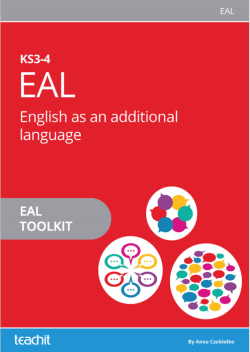EAL toolkit
Our EAL toolkit is designed for teachers and teaching assistants who don’t have a background in teaching English as an additional language to support EAL students in mainstream classrooms at key stage 3 and key stage 4.
What’s included?
This 74-page downloadable toolkit includes:
- general classroom strategies to support EAL learners
- an outline of the challenges faced by international new arrivals
- fun and engaging EAL teaching ideas
- EAL activities for new arrivals who are total beginners
- printable EAL support resources and EAL displays for classrooms
- a CPD PowerPoint for staff training and meetings
- a glossary of English language teaching terminology
- a list of EAL websites for teachers with links to EAL assessment materials.
This EAL toolkit will be invaluable for subject teachers, form tutors, heads of year and SENCos who wish to develop their understanding of the learning approaches you can use to support EAL pupils.
How does it support EAL learners?
The toolkit recommends general classroom strategies to support EAL learners, such as setting up a buddy system with a student who speaks the same home language. It also includes fun and engaging EAL teaching ideas, such as games, songs and role-plays, helping EAL students to feel less anxious about taking part in whole-class activities. It suggests EAL activities for new arrivals who are total beginners, such as labelling images and diagrams, and for those who have a more advanced level, such as adding complexity to sentences.
It includes printable EAL classroom resources, such as an alphabet letters mat, phonics mats, word mats, flashcards, sentence builders and writing frames that can also be used as templates for you to make your own, along with printable EAL support resources that could also be used as EAL displays for classrooms, such as an irregular verbs list, a tenses table, a list of easily confused words or homophones, a list of prefixes and suffixes and a list of common verbs used in academic writing.
It demonstrates how to adapt worksheets for EAL learners in order to support them with both language development and subject knowledge. It offers advice on how to pre-teach vocabulary before a reading or listening activity and how to help students who are learning English as an additional language identify key words and learn new vocabulary from a reading or listening text.
About the writer
Our EAL toolkit was written by Anna Czebiolko, currently a secondary head of EAL. Since starting to work with EAL learners in 2009, she has worked with children in every year group from nursery to sixth form. She also has experience of coordinating EAL provision in a large secondary academy.
What’s inside?
- Introduction
- Introducing survival vocabulary (tier 1 words)
- Improving general academic vocabulary and literacy (tier 2 words)
- Improving subject-specific vocabulary and literacy (tier 3 words)
- Improving listening and speaking skills (oracy)
- Improving reading and writing skills (literacy)
- Further support
Find more EAL teaching resources in our English as an additional language collection.
You might also like Anna's article on Integrating EAL support into mainstream teaching.
Please note that this toolkit is a digital download, but it is not included in a Premium subscription.
An extract from EAL toolkit:
Morphology (the way words are formed)
Spend time helping students to understand the origin of words and their morphology. If students know the meanings of root words, roots, prefixes and suffixes, they are more likely to understand a word containing these word parts; for example: submarine, unfriendly, prehistoric.
Word families
Creating a word family chart builds phonemic awareness, a key to success in reading and listening, and it will be easier for students to understand words if they recognise prefixes and suffixes. Word families are also a simple way for students to expand their vocabulary for speaking and writing.
|
help |
read |
|
helper helping helpful helpless unhelpful |
misread reader reading reread reads |

